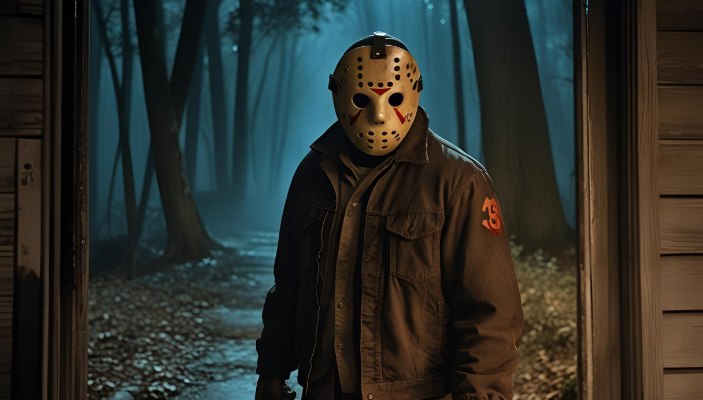Released in 1980, Friday the 13th carved a permanent place in horror history. Directed by Sean S. Cunningham, this low-budget film wasn’t the first slasher, but it sparked a wildfire of imitators and sequels, helping shape modern horror cinema. More than just gore or jump scares, Friday the 13th tapped into cultural anxieties and redefined fear for an entire generation.
This article offers a thoughtful look at Friday the 13th, exploring how it built suspense, why it resonated with audiences, and how it helped shape the slasher genre without using gimmicks or overused tricks.
The Premise: Camp Crystal Lake’s Ominous Legacy
Set in the fictional Camp Crystal Lake, the story follows a group of young counselors trying to reopen the summer camp after years of closure. Unknown to them, the camp holds dark secrets linked to past tragedies—including the mysterious drowning of a boy named Jason Voorhees. One by one, the counselors fall victim to a silent, brutal killer.
The plot is simple, yet its execution relies heavily on timing, isolation, and an eerie atmosphere rather than elaborate storytelling. The quiet woods, the sound of rustling leaves, and long stretches of silence all work together to heighten anxiety and make viewers uncomfortable.
Characterization: More Than Just Victims
Many early slashers presented characters as mere filler—placed only to die dramatically. However, Friday the 13th offered characters with personalities, flaws, and small stories of their own. While they weren’t deeply developed, viewers got a glimpse into their friendships and fears, which made their deaths more impactful.
Pamela Voorhees, the original killer, added a unique layer to the narrative. Her grief-fueled rage brought an emotional undertone rarely seen in similar films at the time. Rather than a masked maniac with no motive, the first movie’s antagonist had a reason—even if it was horrifying.
Jason Voorhees: From Tragedy to Horror Icon
Jason’s role in the original film is limited to a flashback and a shocking final scene. However, it was this twist—his emergence from the lake—that laid the groundwork for a cultural icon. In later films, Jason took over as the central villain, with his signature hockey mask becoming instantly recognizable across the globe.
Though initially absent, Jason became symbolic of horror itself: relentless, silent, and unstoppable. His transformation from a drowned child to a near-mythical killer reflects the evolution of fear itself—moving from trauma to legend.
Aesthetic Choices: Building Tension with Simplicity
The film’s visual style didn’t rely on grand sets or expensive effects. It used nature—trees, fog, cabins, water—to evoke primal fears. The cinematography often placed the camera at odd angles or through bushes, subtly suggesting the killer’s point of view. These decisions built anticipation and placed the audience inside the threat.
Composer Harry Manfredini’s chilling score played a huge role in its tension. The “ki-ki-ki, ma-ma-ma” whisper became synonymous with approaching danger. Minimalist yet effective, the music enhanced suspense without overwhelming the story.
Themes: Paranoia, Guilt, and Urban Myths
Friday the 13th didn’t just aim to scare—it tapped into deeper themes. Parental guilt, teen recklessness, and the idea that evil can exist even in places meant for joy (like summer camps) all play subtle roles. The film also leaned on urban myths—cautionary tales passed down to warn kids—making it feel oddly familiar even on first watch.
There’s also the punishment element: characters engaging in drinking, sex, or ignoring rules often met grim fates. This pattern mirrored societal concerns of the 1980s, particularly among more conservative viewers.
Cultural Impact: A Blueprint for Slashers
After Friday the 13th, horror saw a boom in slasher films. It wasn’t the first (films like Halloween came earlier), but it made the formula commercially successful: isolated setting, young adults, an unknown killer, and a final twist. Over time, it inspired countless sequels, parodies, merchandise, and fan conventions.
Jason Voorhees became more than a character—he became a horror symbol. His name alone evokes a particular brand of horror: brutal, relentless, and emotionally distant. Later sequels took on supernatural angles, pitting Jason against everything from telekinetic teens to Freddy Krueger. While the quality varied, the franchise never lost its core audience.
Critics vs. Fans: Mixed Reviews, Lasting Popularity
When it first released, critics were harsh—calling it exploitative and lacking depth. However, fans had a different view. The film’s raw tension, creative kills, and memorable characters gave it long-lasting popularity. Over the years, even some critics have reevaluated its contribution to horror history.
Today, it’s considered a classic—not because it was perfect, but because it tapped into something primal. Fear doesn’t always come from grand ideas. Sometimes it’s the shadow behind the tree or the creak in an empty cabin.
Legacy and Longevity: Why It Still Matters
More than four decades later, Friday the 13th still draws new viewers. Its simplicity, style, and atmosphere continue to influence filmmakers. The franchise has seen reboots, lawsuits over character rights, and even video games, yet the original still stands strong.
Fans celebrate it every actual Friday the 13th, with marathons, cosplay, and online discussions. It’s more than just a movie—it’s a community, a symbol of how low-budget storytelling can make a lasting impression.
Final Thoughts: Simplicity as Strength
What sets Friday the 13th apart isn’t just its violence or masked killer. It’s the quiet moments, the simplicity of its plot, and its ability to tap into basic human fears. The woods. The dark. Being watched. Being alone.
This film didn’t try to impress with complexity. Instead, it focused on mood, suspense, and pacing. And that’s exactly why it still holds up in a world full of digital effects and psychological thrillers.
Whether you’re a horror fan or just curious about genre-defining movies, Friday the 13th remains an essential watch—not for its gore, but for the way it reshaped fear for the screen.

